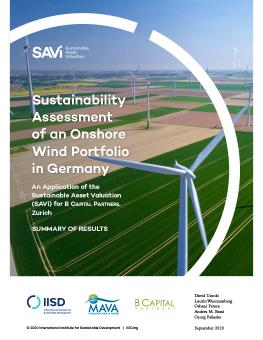
Sustainability Assessment of an Onshore Wind Portfolio in Germany
An Application of the Sustainable Asset Valuation (SAVi) for B Capital Partners
The Sustainable Asset Valuation (SAVi) methodology was customized to conduct a comparative sustainability assessment of the onshore wind portfolio in Germany and a hypothetical gas-fired power plant with the same power generation capacity. The assessment integrates environmental, social, and economic costs and benefits into the asset valuation to improve the transparency of each asset's impacts on the environment and important stakeholders. It also evaluates the financial resilience of the wind portfolio and the gas-fired power plant to climate change risks.
The sustainability assessment consists of the following steps:
- Valuing, in financial terms, the environmental, social, and economic costs and benefits (externalities) caused by the two energy generation assets.
- Assessing the potential costs induced by climate change risks and how the implied costs affect the financial performance of the energy generation assets if those risks materialize. Air temperature increase (physical climate risk) and the introduction of a carbon tax (transitional climate risk) were assessed as climate risks.
- Integrating the valued externalities and climate risk-related costs into the three components of the assessment:
- Cost-benefit analysis.
- Calculation of the levelized cost of electricity.
- Financial analysis, calculating performance results for the equity and project internal rate of return of both assets.
The results across the three assessment components demonstrate that the wind portfolio is the more climate resilient and more profitable investment choice as well as the more beneficial (less costly) energy generation asset from a societal point of view.
Participating experts
Additional downloads
Funded by
You might also be interested in
New Initiative Supports Nature-Based Infrastructure for Climate Adaptation
A USD 2 million grant will fund a new venture in partnership with GEF, the MAVA Foundation, IISD, and UNIDO.
Sustainable Asset Valuation of the Kalivaç and Poçem Hydropower Projects
The SAVi results suggest that the hydropower assets cannot be considered a preferable solution to generate electricity for the Albanian people.
Sustainable Asset Valuation (SAVi) Assessment of the N'Diaye Wind Farm in Senegal
This SAVi analysis on the N'Diaye wind farm project in Senegal demonstrates that, compared to other energy technologies (coal and high-fuel oils), the wind project brings the most benefits to the Senegalese economy and environment.
A Sustainable Asset Valuation of the FAME II policy in India
This report presents the economic valuation of the second phase of the Faster Adoption and Manufacturing of Electric (& Hybrid) Vehicles (FAME II) policy in India and demonstrates its economic, social, and environmental outcomes under different scenarios.